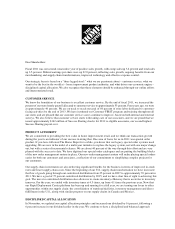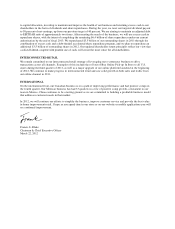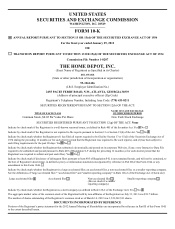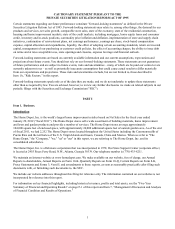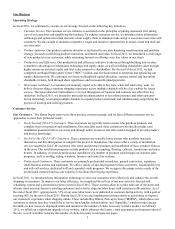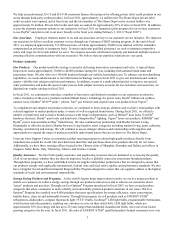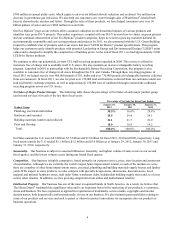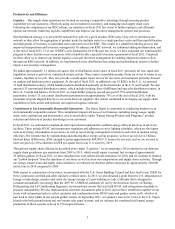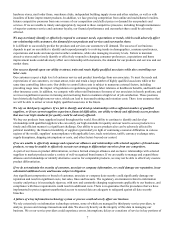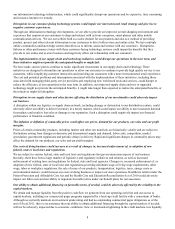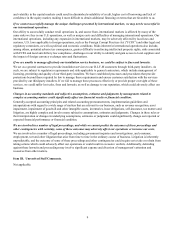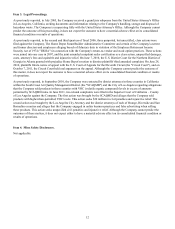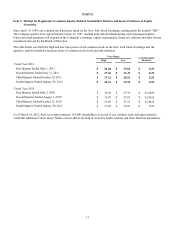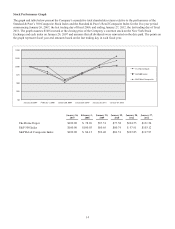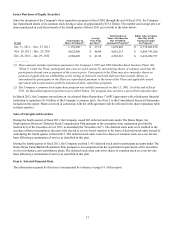Home Depot 2011 Annual Report Download - page 11
Download and view the complete annual report
Please find page 11 of the 2011 Home Depot annual report below. You can navigate through the pages in the report by either clicking on the pages listed below, or by using the keyword search tool below to find specific information within the annual report.
5
Productivity and Efficiency
Logistics. Our supply chain operations are focused on creating a competitive advantage through ensuring product
availability for our customers, effectively using our investment in inventory, and managing total supply chain costs.
Following the completion of our RDC rollout, our initiatives in fiscal 2011 have been to further optimize and efficiently
operate our network, build new logistics capabilities and improve our inventory management systems and processes.
Our distribution strategy is to provide the optimal flow path for a given product. RDCs play a key role in optimizing our
network as they allow for aggregation of product needs for multiple stores to a single purchase order and then rapid allocation
and deployment of inventory to individual stores upon arrival at the RDC. This results in a simplified ordering process and
improved transportation and inventory management. To enhance our RDC network, we continued adding mechanization, and
at the end of fiscal 2011, 15 of our 19 RDCs were mechanized. Over the past two years, we have expanded our transload pilot
program to three facilities near ocean ports, with a fourth facility expected to become operational in fiscal 2012. Transload
facilities allow us to improve our import logistics costs and inventory management by enabling imported product to flow
through our RDC network. In addition, we implemented a new distribution forecasting and replenishment system to further
improve our inventory management.
We added approximately 1.5 million net square feet of distribution center space in fiscal 2011, primarily for new repair and
liquidation centers as part of our centralized returns system. These centers consolidate product from our stores to return to our
vendors, liquidate or recycle. They also provide a small engine repair service for our stores and customers primarily focused
on outdoor and hardware power equipment. At the end of fiscal 2011, in addition to our 19 RDCs in the U.S., we operated
33 bulk distribution centers, which handle products distributed optimally on flat bed trucks, in the U.S. and Canada. We also
operated 35 conventional distribution centers, which include stocking, direct fulfillment and specialty distribution centers, in
the U.S., Canada and Mexico. In fiscal 2011 we made further progress toward our goal of 75% central distribution
penetration. In the U.S. our central distribution penetration was approximately 70% as of the end of fiscal 2011, with the
remainder of goods shipped directly to our stores from our suppliers. We remain committed to leveraging our supply chain
capabilities to fully utilize and optimize our improved logistics network.
Commitment to Environmentally Responsible Operations. The Home Depot is committed to conducting business in an
environmentally responsible manner. This commitment impacts all areas of our business, including energy usage, supply
chain, store construction and maintenance, and, as noted above under "Energy Saving Products and Programs," product
selection and delivery of product knowledge to our customers.
In fiscal 2011, we continued to implement strict operational standards that establish energy efficient practices in all of our
facilities. These include HVAC unit temperature regulation and adherence to strict lighting schedules, which are the largest
sources of energy consumption in our stores, as well as use of energy management systems in each store to monitor energy
efficiency. We estimate that by implementing and utilizing these energy saving programs, we have saved over 4.5 billion
kilowatt hours (kWh) since 2004, enough to power approximately 400,000 U.S. homes for one year, and we are on track to
meet our goal of a 20% reduction in kWh per square foot in our U.S. stores by 2015.
Through our supply chain efficiencies described above under "Logistics," we are targeting a 20% reduction in our domestic
supply chain greenhouse gas emissions from 2008 to 2015, which would equate to annual fuel savings of approximately
25 million gallons. In fiscal 2011, we also calculated our total carbon dioxide emissions for 2010, and we continue to monitor
our "carbon footprint" from the operation of our stores as well as from our transportation and supply chain activities. Through
our energy conservation and supply chain initiatives, we reduced our absolute carbon emissions by approximately 540,000
metric tons in 2010 compared to 2009.
With respect to construction of our stores, we partnered with the U.S. Green Building Council and have built seven LEED for
New Construction certified and other similarly certified stores. In 2011, we also obtained a grant from the U.S. Department of
Energy to help design, monitor and verify the energy savings of a new building in Lodi, California that is designed to
consume substantially less energy than the 2007 90.1 ASHRAE standards set out by the American Society of Heating,
Refrigerating and Air-Conditioning Engineers, an international society that sets forth HVAC and refrigeration standards to
promote sustainability. We also implemented a rainwater reclamation pilot in 2010, and we have retrofitted a number of our
stores with reclamation tanks to collect rainwater and condensation from HVAC units and garden center roofs, which is in
turn used to water plants in our outside garden centers. In September 2011, we opened a store in St. Croix in the U.S. Virgin
Islands with both ground mount and roof mount solar panel systems, and we estimate the combined total annual energy
production of these systems to be up to 570 megawatt hours.



